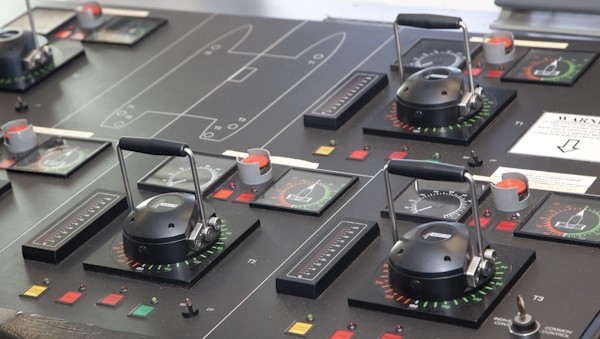China Analysts Expect US to Ease Export Curbs for Magnet Relief
Chinese analysts expect the US to dial back new export control rules targeting thousands of Chinese firms when presidents Xi Jinping and Donald Trump meet this week.

Dynamic positioning controls. Photo (c) Robert Almeida/gCaptain
The U.S. Bureau of Safety and Environmental Enforcement (BSEE) and the U.S. Coast Guard have today issued a Joint Safety Alert in response to a dynamic positioning incident involving an Offshore Supply Support Vessel while conducting critical activities on the Outer Continental Shelf, resulting in the loss of position.
Without going into detail on where and when the incident occurred, the joint alert said that the OSV lost position while attached to a wellhead, severing the wellhead tree and causing a lubricant release on the platform deck and to the environment.
Safety Alerts are issued by BSEE to inform the offshore oil and gas industry of the circumstances surrounding an incident or a near miss, and also contain recommendations that should help prevent the recurrence of such an incident on the OCS.
The full text of the safety alert, Coast Guard Alert 01-15 or BSEE Alert #315, can be read in full below:
DYNAMIC POSITIONING SYSTEM FAILURES ON OFFSHORE SUPPLY VESSELS ENGAGED IN OIL AND GAS OPERATIONS IN THE U.S. OUTER CONTINENTAL SHELF
Discussion: This Joint Safety Alert addresses a dynamic positioning (DP) incident involving an Offshore Supply Vessel (OSV) which resulted in a loss of position while conducting a critical Outer Continental Shelf (OCS) activity. The OSV was attached to a wellhead, lost position and severed the wellhead tree causing a lubricant release on the platform deck and to the environment. Immediately prior to the position loss, the OSV had multiple DP system alarms and failures, including loss of bow thruster and engine control. No attempt was made to identify or correct the causes of these failures and the operations continued.
At the time of the position loss, the OSV was being utilized to support pump and electric line equipment which was connected to the well at the time of the incident. Specifically, when the vessel lost position, the vessel operator was in the process of removing a downhole DX plug from the well via wireline. High pressure pump lines were also connected to the well, although actual pumping operations were not in progress. When the vessel lost position, the Christmas tree was sheared from the well because of the force exerted on it by virtue of the connected high pressure lines. Severe consequences were averted because a subsurface safety valve was activated and there was an absence of hydrocarbon flow from the well.
The OCS activity performed was critical due to the short time to terminate and the potential uncontrollable release of hydrocarbons from a well with known sustained casing pressure. The Coast Guard and the BSEE are issuing this joint Safety Alert because we share jurisdiction on the OCS and wish to highlight the importance of an OSV’s Safety Management System (SMS) and a leaseholder’s Safety and Environmental Management System (see Reference 1).
This incident highlights the following critical issues:
Alarms: The Coast Guard and BSEE stress the importance of properly acknowledging and investigating all alarms, and taking immediate and positive corrective action prior to initiating or proceeding with any critical OCS activity.
SMS: The OSV was not required to and did not have an International Safety Management (ISM) Code certificate. The Coast Guard reminds OSV owners and operators that an effective SMS is essential to safe operations, particularly when those operations are critical OCS activities. Had the OSV implemented an effective SMS, as described in the ISM code, it likely would have:
Dynamic Positioning: The Coast Guard strongly recommends owners and operators of OSVs using DP to follow DP guidance provided in reference 3 (Marine Technology Society (MTS) DP operations guidance) when conducting critical activities on the U.S. OCS. See the applicable notice on this topic published in the Federal Register (77 FR 62247, October 12, 2012) for more details. Had this OSV followed the MTS DP operations guidance it likely would have:
Leaseholder/operator SEMS: BSEE strongly recommends leaseholders/operators consider Coast Guard recommendations for DP vessels when evaluating potential hazards and establishing/implementing contractor safe work practices in their SEMS program (see 30 CFR §§ 250.1911 and 250.1914). BSEE reminds leaseholders/operators of their critical role in ensuring safety and environmental hazards associated with contracted vessels on their lease are properly managed. For example, leaseholders/operators should ensure hazards associated with a loss of position by contracted DP vessels are analyzed and managed with appropriate contractor safe work practices.
For additional information, contact Lieutenant Commander Elizabeth Massimi at (504) 671-2156 with the Coast Guard District 8 Prevention Division or Troy Trosclair at 504-736-2923 with the BSEE Gulf of Mexico Region.
Reference 1: BSEE/USCG Memorandum of Agreement OCS-07 “Safety and Environmental Management Systems (SEMS) and Safety Management Systems (SMS)” (April 30, 2013).
Reference 2: ISM Code Regulations 7 and 10 (2014 ed.).
Reference 3: DP Operations Guidance, Part 2 Appendix 2: DP Project /Construction Vessels (Dynamic Positioning Committee of the Marine Technology Society to aid in the safe and effective management of DP Operations (July 31, 2012).
Reference 4: Marine Technology Society Technical and Operations Guidance (TECHOP) “Defining Critical Activities Requiring Selection of Critical Activity Mode”, TECHOP_ODP_12_(O) (January 2014).
This and other current Safety Alerts issued by the BSEE can be found HERE.
Looking for more insight? Follow the discussion in the gCaptain FORUM.

Sign up for gCaptain’s newsletter and never miss an update

Subscribe to gCaptain Daily and stay informed with the latest global maritime and offshore news
Essential news coupled with the finest maritime content sourced from across the globe.
Sign Up